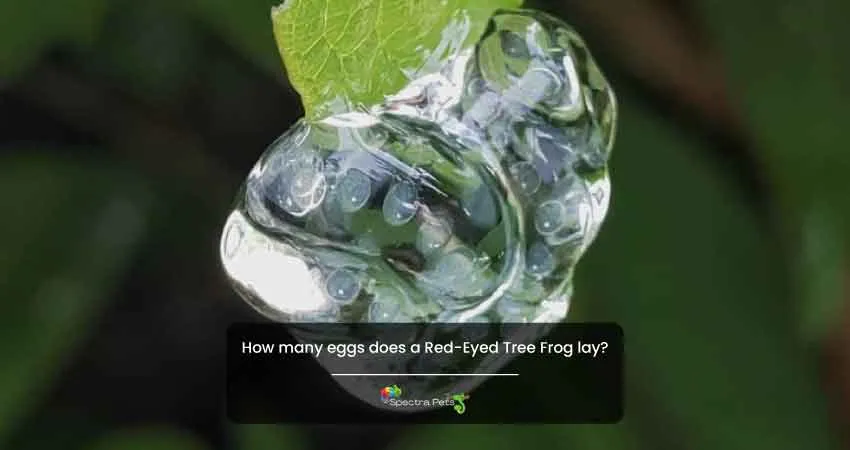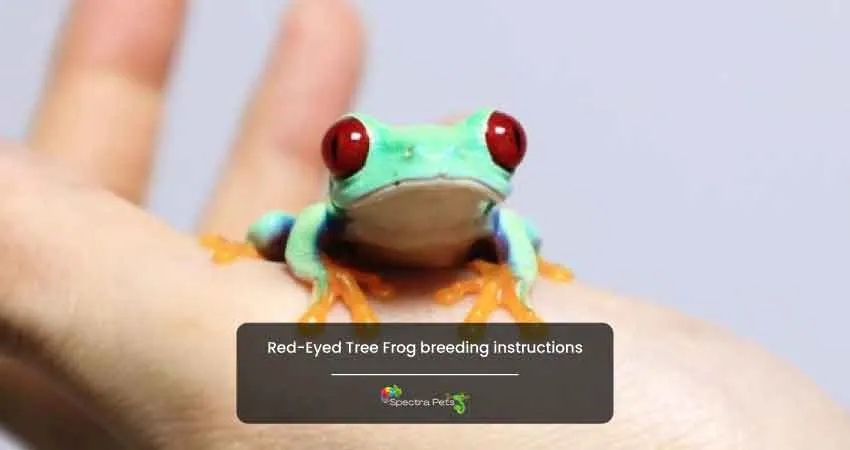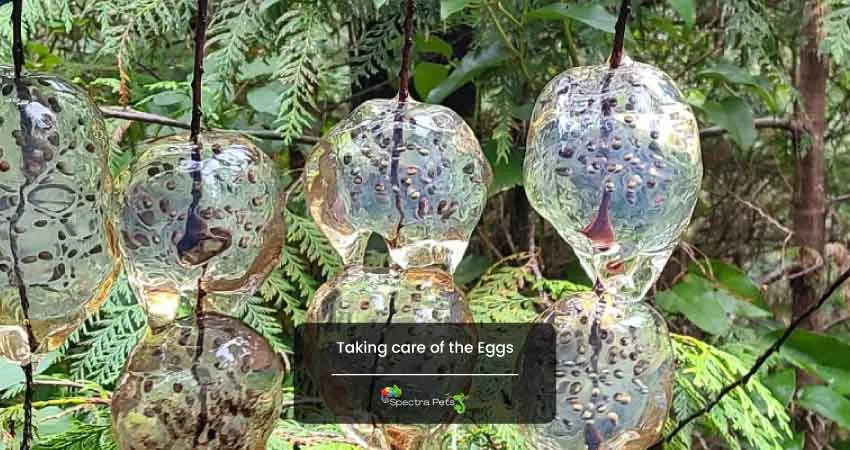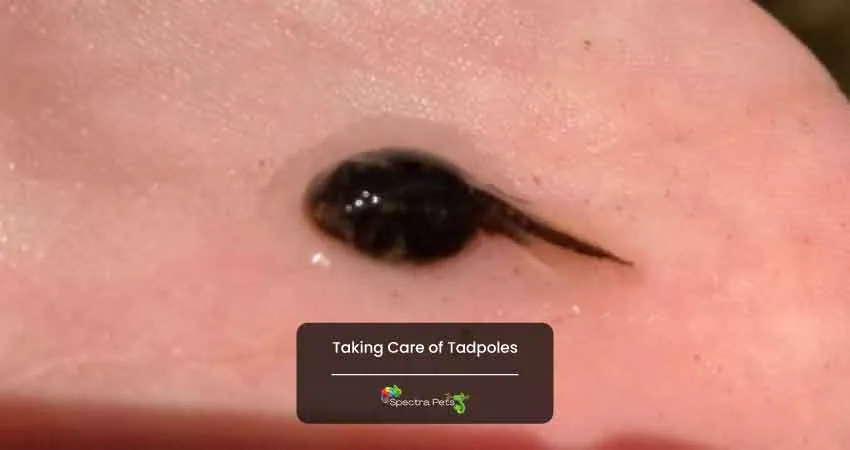The Red-Eyed Tree Frogs are colorful and nocturnal frogs. It’s simple to keep them, and they are not too difficult to breed. There should be little questions as to why they’re so popular.
Most of the red-eyes sold in the U.S. are captured from the wild; these animals frequently arrive ill and parasitized. Also, they do not fare well in captivity. In addition, there are the potential environmental effects of taking so many of these creatures out of their natural habitats.
In this piece, I will try to guide you through the basics of successfully breeding these beautiful Red-eyed tree frogs, as this is quite an accomplishment as a pet frog owner!
What is a Red-Eyed Tree Frog?

The Red-Eyed Tree Frog is a tree frog that can be found in lowland rainforests along streams, ponds, and rivers due to the need for water for their offspring to mature. These frogs are entirely arboreal (tree dwellers) and typically live in groups near water sources. They hardly ever touch the ground.
Taxonomy
- Kingdom: Animalia
- Phylum: Chordata
- Class: Amphibia
- Order: Anura
- Family: Hylidae
- Genus: Agalychnis
- Species: calidryas
- Scientific name: A. calidryas
Male Red-Eyed Tree Frogs can reach lengths of 2 cm, while females typically reach lengths of up to 4 cm. It is easily recognized because of its protruding red eyes, its body’s mixture of yellow, green, and blue hues, and its orange-colored toes.
This frog conceals its distinctive colors when it is sleeping, but if a predator is going after it, it will show them to frighten or distract the pursuer. The Red-Eyed Tree Frog can climb trees and leaves thanks to suction cups on its toes, just like other tree frogs can. They can climb better than they swim because of their limbs being longer.
This frog, which is a member of the Hylidae frog family, has another eyelid known as “nictitating membrane”. This protects its vulnerable eye from harm. Although it colors the eye into a red hue, it does not impair vision.
How many eggs does a Red-Eyed Tree Frog lay?

This species’ female frogs lay a clutch of 20–60 eggs one by one over water on the underside of a leaf before abandoning the eggs. Tadpoles fling themselves into the water after hatching. The process of metamorphosis lasts for about three months, after which the frogs return to the trees.
Red-Eyed Tree Frog breeding instructions

Red-eyed tree frogs can breed almost all of the time, but there are some preparations you can make to improve the likelihood of a triumphant reproductive session.
Having a carefully controlled environment is essential for red-eyed tree frogs in order to breed in captivity. Only mature, healthy frogs can be subjected to these situations.
Increase the food consumption of your amphibians by about 25%, starting about a month before the intended breeding attempt. Don’t forget to provide feeder insects, like crickets, that have been fed nutritious foods like carrots, sweet potatoes, and greens, and have been gutloaded.
Before giving the insects to your frogs, feed them this improved diet for two days. Be sure to apply a high-quality vitamin/mineral supplement to all insects.
Along with changing their diet, you can simulate the coming rainy season by increasing the temperature inside their enclosure by a bit (while still confirming to keep it under 80F).
Also mist the enclosure more frequently. A rise in temperature is not as significant as a rise in humidity. Alternatively, you can reduce ventilation to raise humidity. However, you should be cautious because foul air can cause bacterial infections.
Begin raising the temperature and misting two weeks prior to the intended breeding attempt. Separate the sexes if the males start to amplex the females.
When you introduce your amphibians to the rain chamber, the male frogs are almost always ready to breed. During the development of the eggs, the females should start to look swollen. It appears as though the backbone is sunken on large female who is carrying eggs due to the side bulges. In particular, in pregnant animals, you can occasionally see eggs through their belly.
Now you should introduce them to the rain chamber, provided both sexes are prepared for breeding.
Rain Chamber
Red-eyed tree frogs procreate in large numbers during or after the rainy seasons. Most breeders construct a rain chamber in order to mimic these conditions in captivity. Any kind of waterproof container, including a sizable aquarium or a plastic trash can that has been modified, can be used to create a rain chamber.
You’ll need one spray bar that is attached to a mini pump and placed at the top of the terrarium. Turning the pump on simulates a rainstorm, and water droplets start falling from above. You have to plug the pump into an electrical timer and submerge it in about 3 inches of water. It should automatically turn on and rain for a few hours several times every night.
For egg deposition, float a number of large tropical plants. These can be raised either epiphytically on cork bark slabs or tree fern panels and covered in sphagnum moss.
You might also consider floating a piece of cork bark on the water to provide frogs with a foothold in case they drop and need to quickly escape. Last but not least, incorporate an aquarium heater that has a thermostat and set the temperature to roughly 80 degrees.
In order to maintain humidity during the day, turn the pump on for 15 minutes in four hour intervals. The frogs must be well fed in advance because you cannot feed them inside the rain chamber and they could stay there for up to a week.
In addition to perches that are both inside and outside of the direct water spray, make sure there are numerous perches available for the red eyes to use when they are not active. Additionally, make sure the frogs, which will fall into the water, can easily escape.
Remove the frogs after the eggs have been laid. The egg masses will drown if the adult red frogs accidentally knock or move them into the water. Usually, eggs are discovered between two to four days after the frogs are put inside the rain chamber.
Taking care of the Eggs

The waiting begins once your eggs are there! 10 to 14 days after being laid, eggs usually begin to hatch.
The egg clutch will develop fairly quickly; in a couple of days, tiny green tadpoles will become visible. These will gradually enlarge until they break the egg’s shell and plunge into the water.
An egg cluster could occasionally be infertile. Discard the eggs if they begin to crumble after going several days without exhibiting any signs of fertilization. When new breeders first lay their eggs or after the red eyes have recently done so, there can be infertile clutches.
An egg mass that is healthy will typically contain a few infertile eggs. Ignore the infertile eggs unless they begin to grow mold, which could spread and ruin the entire clutch. If this happens, get rid of the bad ones.
Taking Care of Tadpoles

Tadpole care is not difficult. In general, you should keep the water quality excellent and feed frequently.
After hatching, keep the tadpoles in the water until they can swim on their own, which typically takes about 4 days. It is now time to transfer the tadpoles to a different tank and start feeding them since their yolk should have been absorbed by this time.
Tadpoles spend the first few weeks of their lives mostly immobile on the aquarium’s bottom. Once they start to move, start giving them fine-flaked fish food and perform periodic partial water changes.
Water quality can be preserved with the aid of a sponge filter. Most tadpoles will finish their metamorphosis in eight weeks if their water is kept at 75 degrees, but some tadpoles will need longer.
Make sure the aquarium has a screen cover because the small red-eyes can climb glass using toe pads once their front arms have grown. To make it easier for newly metamorphosed frogs to climb on, place a small piece of drifting wood or wine cork in the water.
Although tadpoles can be kept together in a group, you should take care not to overcrowd them as they have been known to engage in cannibalism. It is advised to keep 20 to 30 tadpoles in each 5-gallon plastic tub. As the tadpoles grow, decrease the number per tub.
Replace half of the water with fresh water twice per week. This interval increases every other day as tadpole size increases. Daily feedings of tadpoles involve the use of premium tropical fish food, such as Sera Micron, brine shrimp flakes, etc. You must provide enough food so that it can be finished in 10 minutes.
In just 5 to 6 weeks, they will quickly reach a height of 1.5 inches and sprout back legs.
Within two weeks, they will develop “wings,” which are actually just the front legs with the skin peeled back. To prevent newly transformed froglets from escaping the tadpole tank, install a transparent cover on it.
Froglet Care

Take out the freshly transformed red eyes as soon as they move out of the water.
The majority of froglets will try to climb up the glass after morphing, but it’s always a good idea to provide some pieces of wine cork for a quick exit out of the water.
Move recently transformed red-eyes to a basic setup with wet paper towels, a water bowl, and a few plants once they can climb out on their own. Confirm that the tank is kept moist because young frogs are susceptible to desiccation. The rest of the setup can be the same as for adults. For the first month, ten to twenty froglets should be housed in a 5-10 gallon aquarium.
Sort froglets by size as they mature. This will lessen the likelihood that larger siblings will outcompete smaller ones for food.
Baby red-eyed tree frogs should not be given food before the tail has been completely absorbed; the newly hatched frog will continue to consume this for a few following days after emerging from the water.
Each night, once their tails have been absorbed, the froglets will eat fruit flies and crickets. Sprinkle nutritional fluids lightly over each offering.
4 Handy tips and tricks for breeding Red-Eyed Tree Frog

- Male to female ratio should be at least 2:1, and males should be introduced to the rain chamber one or two days before females in order to prevent competition between the sexes, which could promote breeding.
- Try to move to the rain chamber as soon as a thunderstorm starts to develop. According to anecdotal evidence, barometric pressure changes brought on by rainstorms may facilitate successful reproduction.
- If the quality of the water declines, waste that has accumulated will fall on frogs and cause health issues. Therefore, change part of the water everyday.
- After one to two weeks, if breeding has not started, remove the frogs back to their regular terrarium, feed them heavily for another week, and then try again.
Conclusion
In order to achieve brilliant breeding results, you must inform yourself well enough about the breeding cycle of the Red-Eyed Tree Frog. If these frogs can be properly bred and nurtured, they can become a modest income source, as this species of frog is quite rare and beloved amongst pet enthusiasts.
